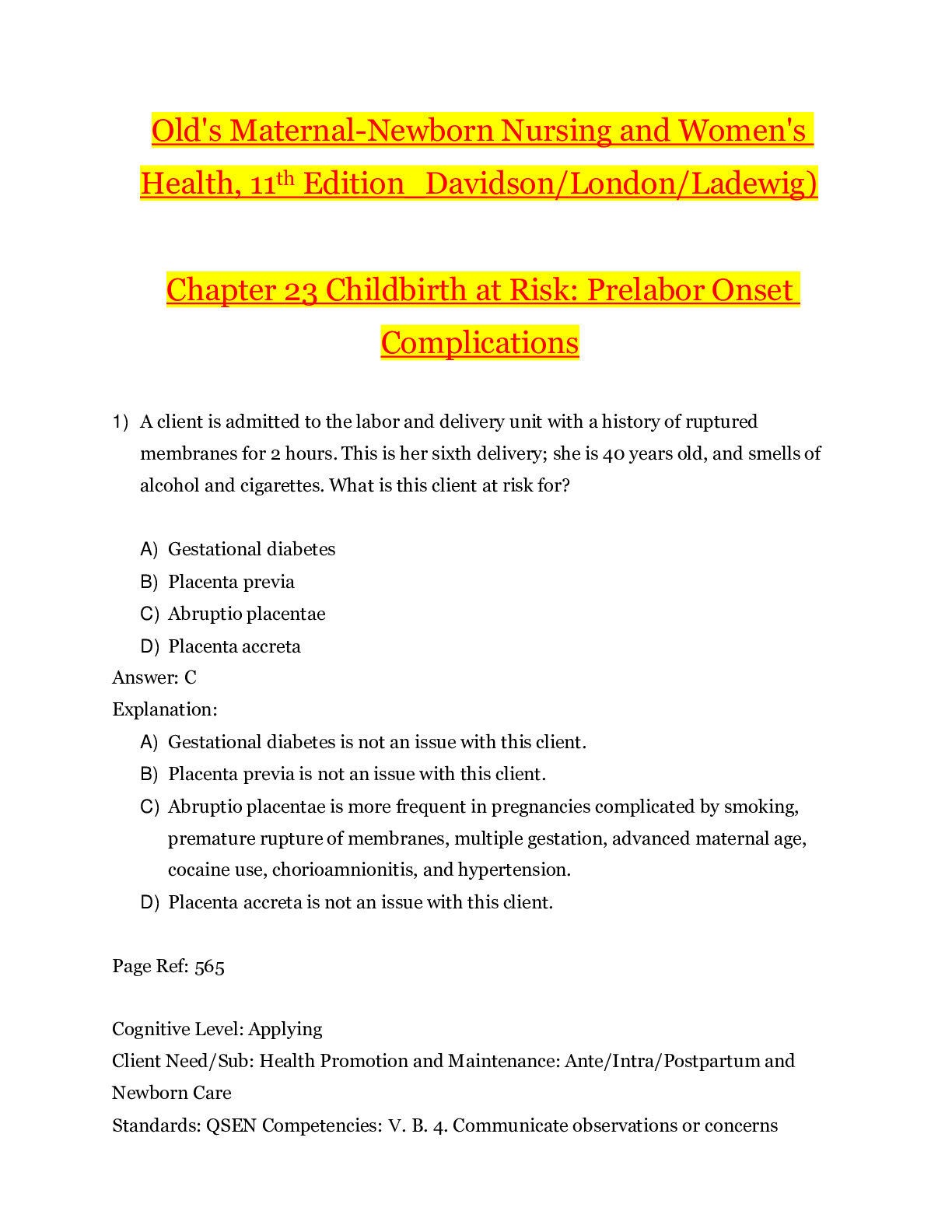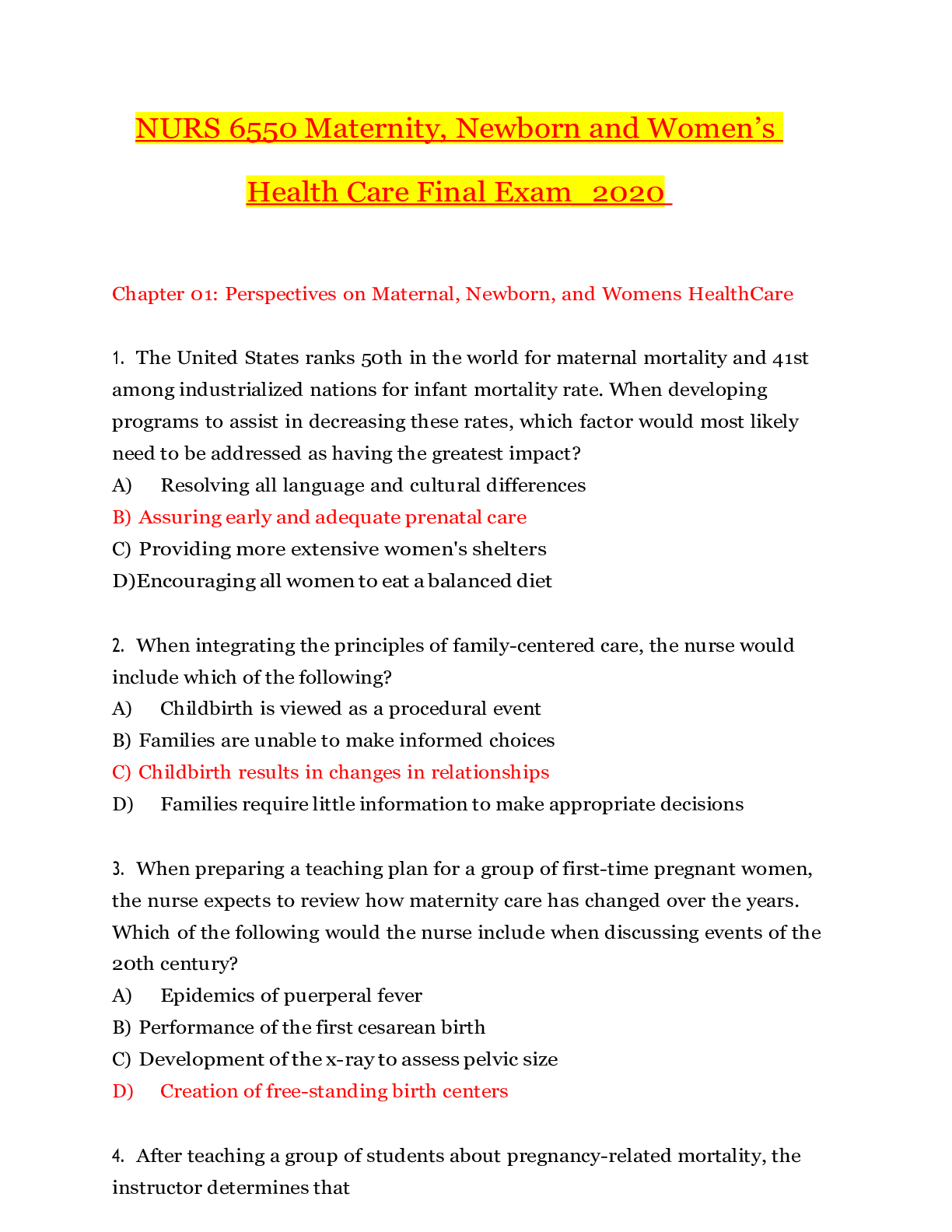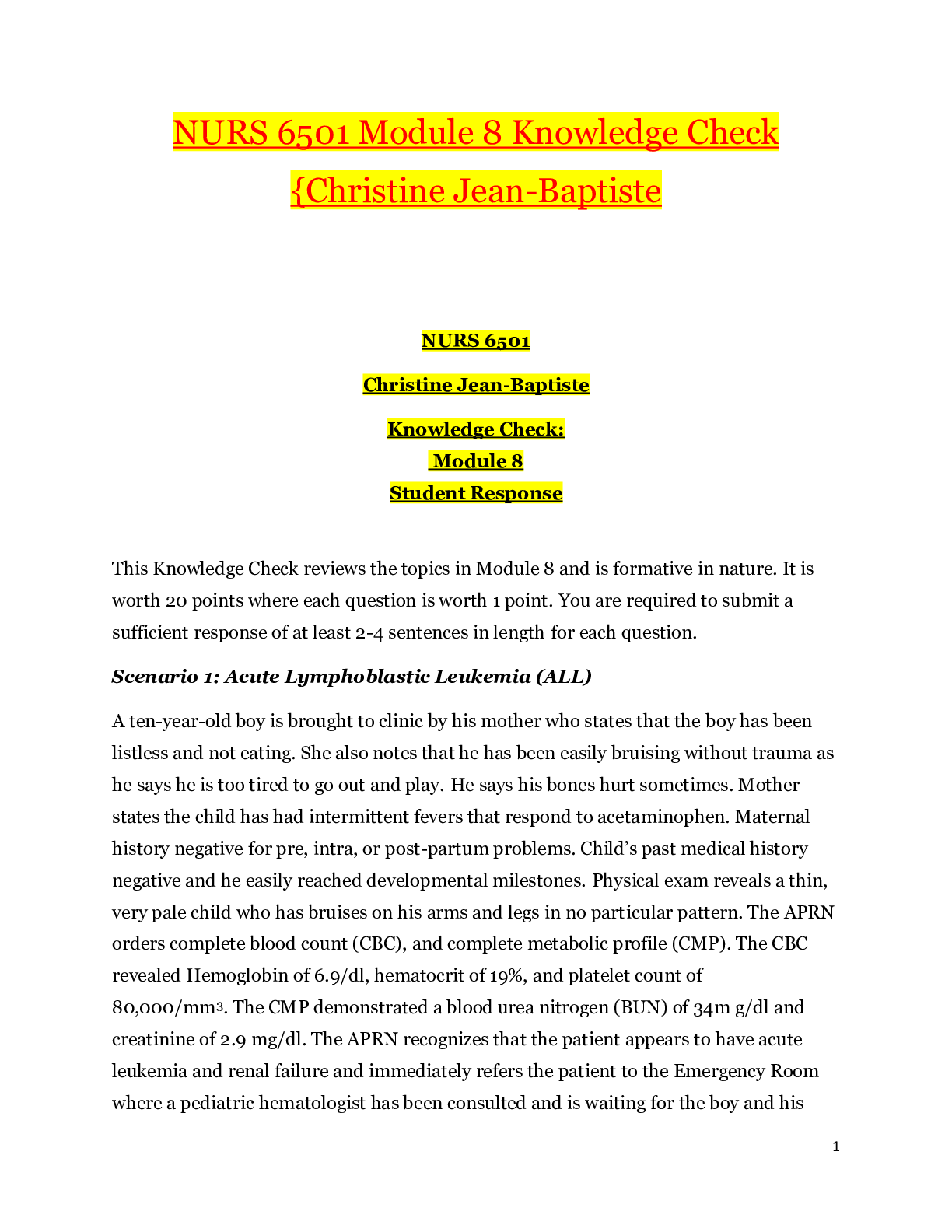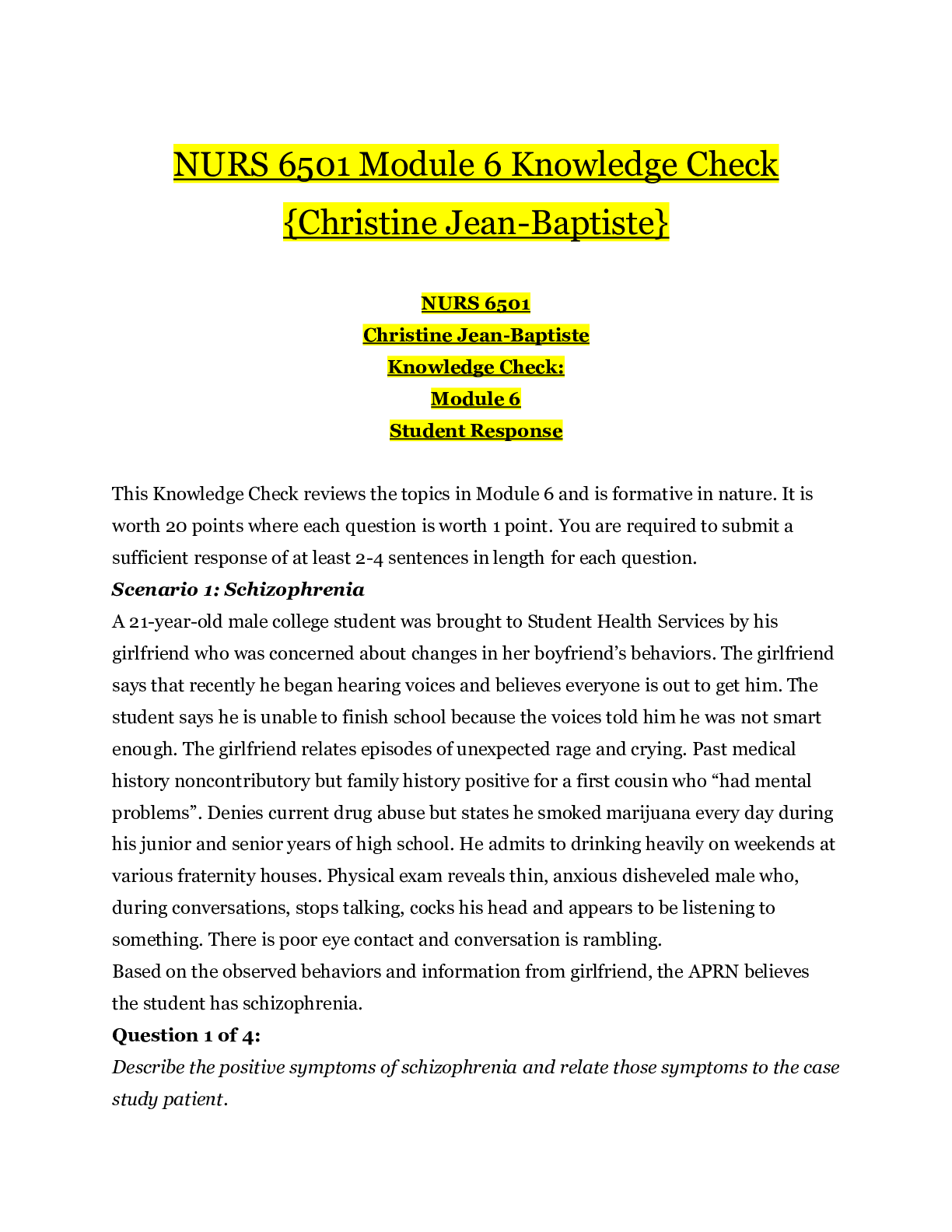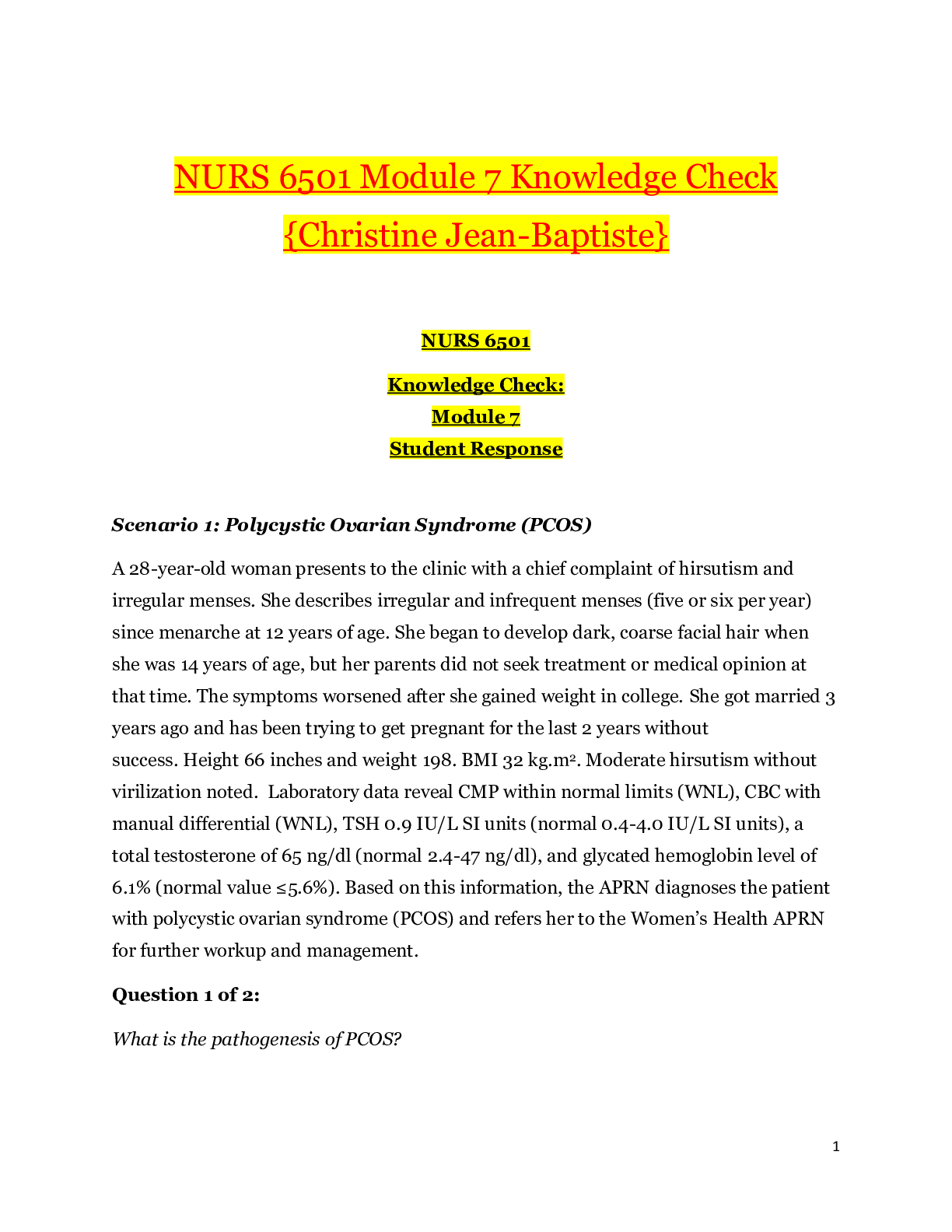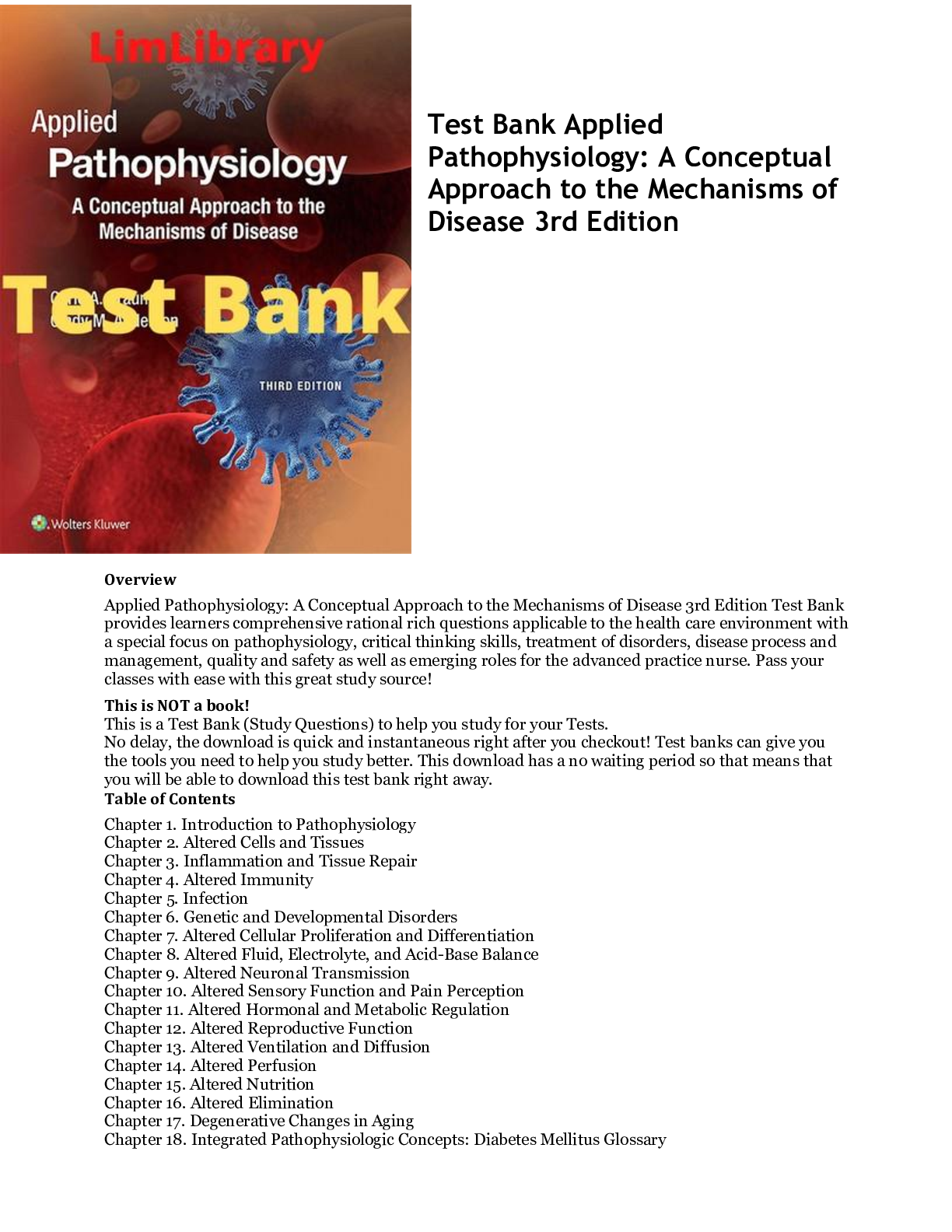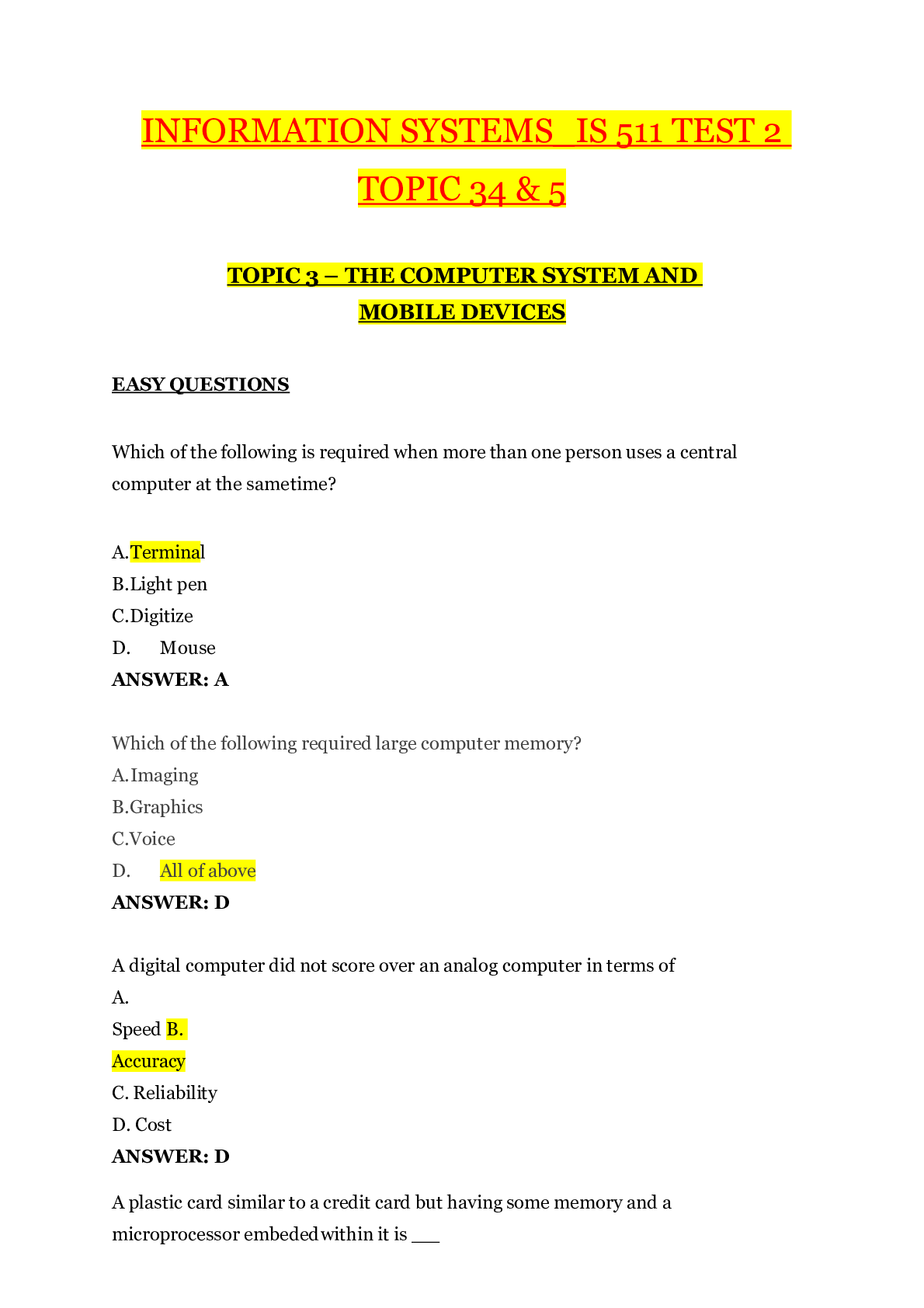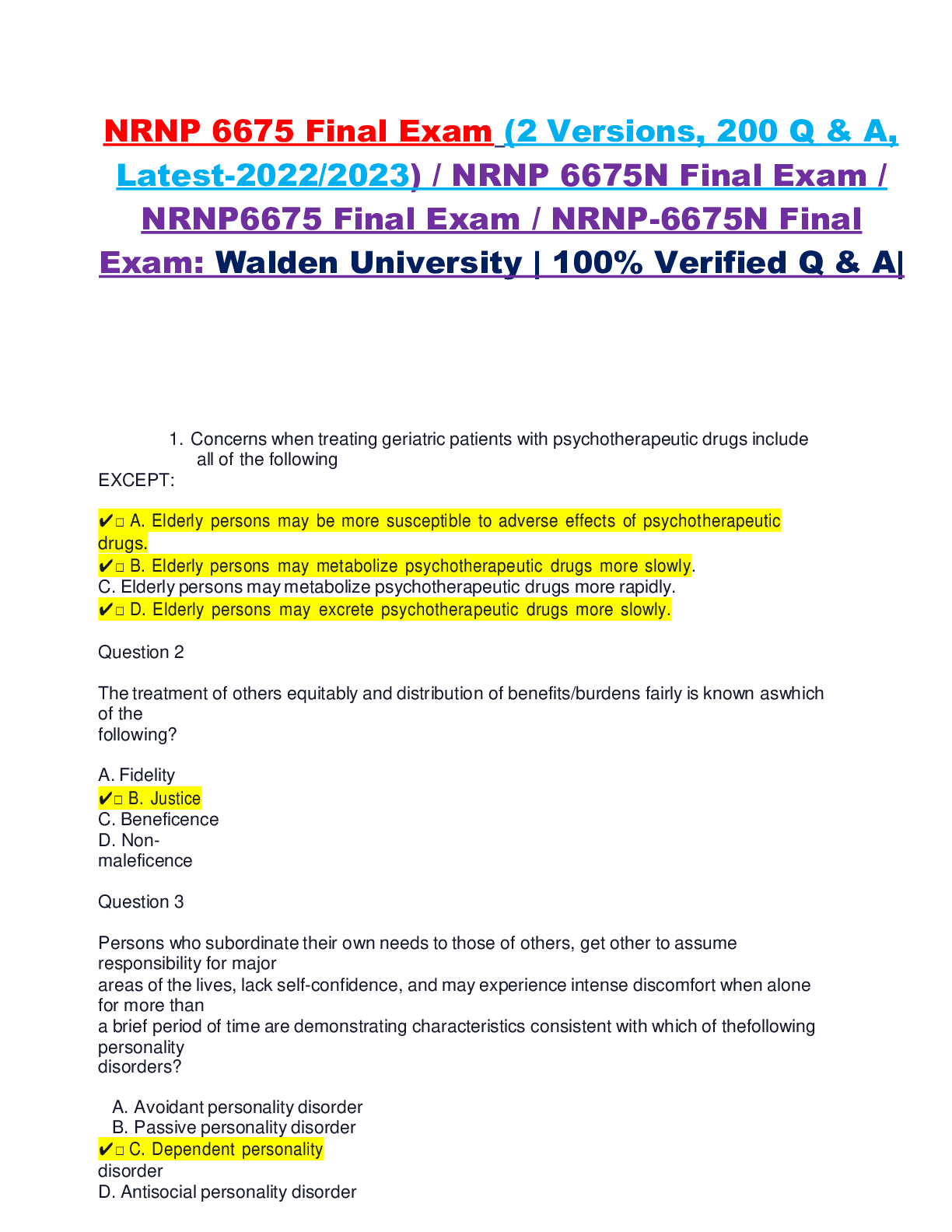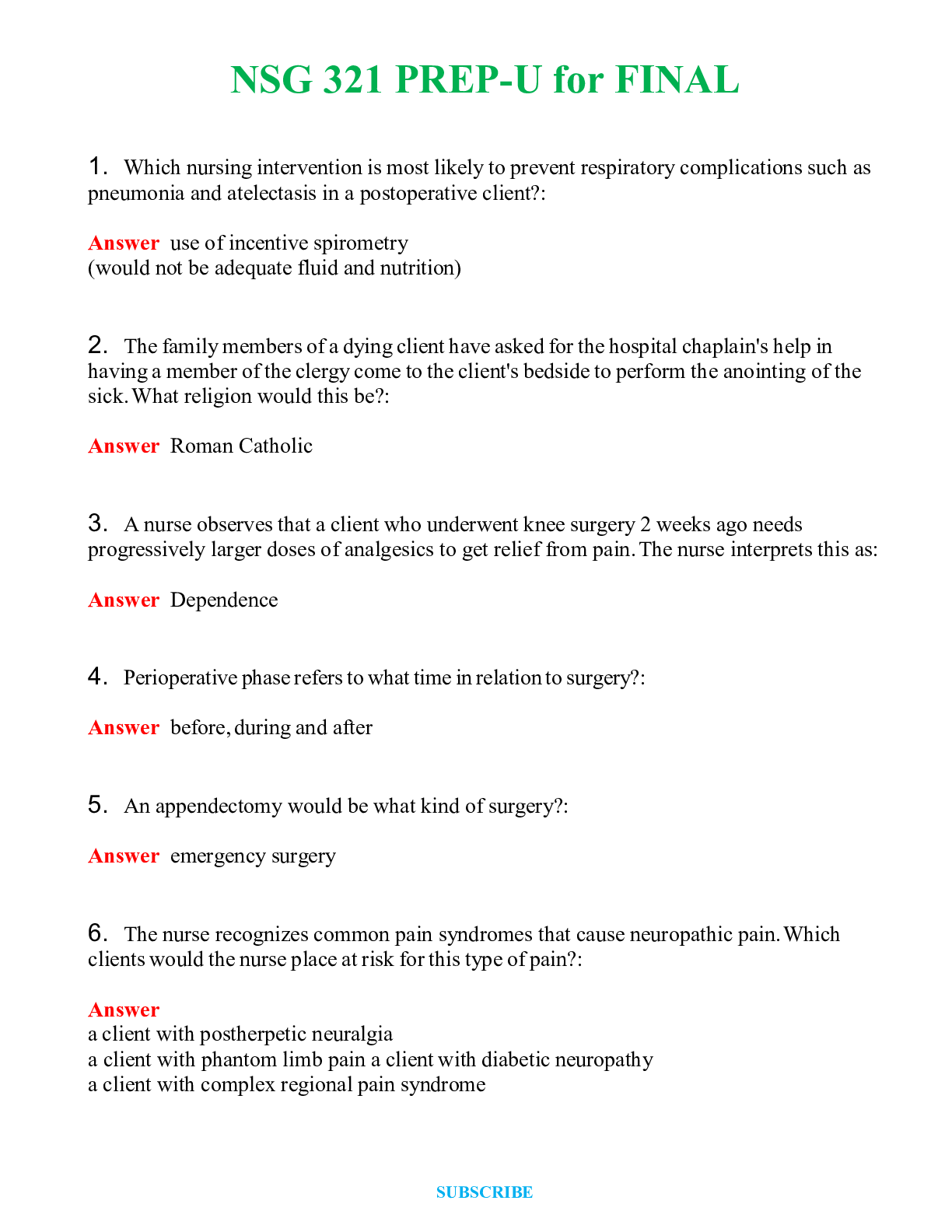Pharmacology > EXAM > Pediatrics Module 4 Test Review_2020 | Pediatrics Module 4 Test Review_Graded A (All)
Pediatrics Module 4 Test Review_2020 | Pediatrics Module 4 Test Review_Graded A
Document Content and Description Below
Pediatrics Module 4 Test Review_2020 - Gurnick Academy of Medical Arts Lesson 1-Ch 26 1. Describe the major goal for pediatric nursing (p. 689). · The major goal of pediatric nursing is to improve... the quality of health care for children and their families. · The health status of children in the United States has improved in several areas including increased immunization rates for all children, decreased adolescent birth rate, and improved child health outcomes. · Key examples of child health promotion themes essential for all age groups include promoting development, nutrition, and oral health. *childhood health problems 2. List 5 childhood health problems and consider ways that pediatric nurses can alleviate negative impacts of the problems (pp. 690-694). · Several health problems facing children that are also major challenges for pediatric nurses include obesity/ type 2 diabetes, childhood injuries, violence, bullying, and mental health issues. o Obesity/ Type 2 Diabetes o Childhood Injuries · Injuries are the most common cause of death and disability to children in the United States. Suicide has surpassed MVAs as the leading cause of injury mortality. · The child’s developmental stage primarily determines the types of injuries that are most likely to occur at a specific age and helps provide clues to preventive measures. o Violence o Bullying o Mental Health Issues · 1 of 5 children has a mental health problem, and 1 out of 10 has a serious emotional problem that affects daily functioning. The nurse is admitting a school-age child with the most common nutritional problem among children in The United States. The nurse knows that the child has the following: a. Anemia. b. Bulimia. c. Kawasaki’s disease.d. Obesity Mortality and Morbidity 3. Identify two ways that knowledge of mortality and morbidity can improve child health (p. 694). · Childhood morbidity encompasses acute illness, chronic disease, and disability. · The chief illness of childhood is the common cold. · Children who have increased morbidity are those who are homeless, living in poverty, LBW, chronically ill, foreign-born adopted, and spending time in day care centers. Family Centered Care · The philosophy of family-centered care recognizes that the family is the constant in a child’s life and that service systems and personnel must support, respect, and enhance the family’s strength and competence. 4. Utilize the key elements of family-centered care (p. 695). Role of the Pediatric Nurse 5. Describe five broad functions of the pediatric nurse in promoting the health of children (pp. 696-698). · Atraumatic care is the provision of therapeutic care in settings, by personnel, and through the use of interventions that eliminate or minimize the psychologic and physical distress experienced by children and their families in the health care system. · The pediatric nurse’s roles encompass a therapeutic relationship, family advocacy and caring, disease prevention and health promotion, health teaching, injury prevention, support and counseling, coordination and collaboration, ethical decision making, and research and evidence-based practice. Miscellaneous · EBP is the collection, interpretation, and integration of valid, important, and applicable patient-reported, nurse-observed, and research-derived information. · The process of nursing children and families includes accurate and comprehensive assessment, analysis and synthesis of assessment data to arrive at a nursing diagnosis, planning of care, implementation of the plan, and evaluation of interventions.(ADPIE) · Documentation is essential for nursing evaluation. · Because nurses are the principal caregivers within health care institutions, quality outcomes are used as a measure of the ability to provide excellence in patient care. Lession 1-ch 27 1. Discuss definitions of family (p. 702). · Because there is no agreement about the definition of family, a family is what an individual considers it to be. · Newer concepts of family include communal families, single-parent families, and homosexual families. These family styles are often referred to as “household.” · A family theory can be used to describe families and how the family unit responds to events both within and outside the family. Most nurses use a combination of theories in their work with children and families. · The US Census Bureau defines family in the following ways: traditional nuclear family, nuclear family, blended family or household, and extended family or household. · Each individual has a position, or status, in the family structure and plays culturally and socially defined roles in interactions with the family. o Family Nursing Interventions Family Structure and Function 2. Compare and contrast various family structures (pp. 704-706). Family structure o Traditional nuclear family o Nuclear family o Blended family o Extended family o Single parent familyo Binuclear o Polygamous o Communal o LBGTQI families Family Roles and Relationships Parental Roles Parenting · There are different philosophies in regard to parenting and each family approached discipline differently. 3. Compare and contrast the three various parenting styles (p. 707). Special Parenting Situations · Adoptive parents have fewer sources of support and preparation for the new addition to their family. · Marital factors within the home significantly influence a child’s development. The impact of divorce on a child depends on the child’s age, the outcome, and the quality of the parent-child relationship and parental care following the divorce. · Single parenting and step-parenting create adjustment difficulties and add stress to the already demanding parental role. Significant numbers of children will live in a single-parent or reconstituted family at some point. 4. Demonstrate an understanding of special parenting situations such as divorce and working mothers (pp. 710-712 & 714). o Impact of Divorce on Children o Working Mothers Sociocultural Influences Upon the Child and Family Influences in the Surrounding Environment Broader Sociocultural Influences Upon the Child and Family · Sociocultural influences upon the child and family include race, ethnicity, social class, poverty, religion, and mass media. Understanding Cultures in the Health Care Encounter · Nurses have a responsibility to understand the influences of culture, race, and ethnicity on the development of social and emotional relationships, childrearing practices, and attitudes toward health. · Cultural beliefs related to cause of illness and maintenance of health may focus on natural forces, supernatural forces, or an imbalance of forces. · No cultural group is homogeneous; every racial and ethnic group contains great diversity. · Religious practices greatly influence health promotion beliefs in families. 5. List the 3 tenets of cultural humility (p. 719). · The practice of cultural humility is continual and an important concept in the nursing process. Nurses can facilitate this process by recognizing cultural differences, integrating cultural knowledge, being aware of their own beliefs and practices, and acting in a culturally appropriate manner. o Cultural Definitions Lesson 1 ch 28 Growth and Development · Growth is a change in quantity and occurs when cells divide and synthesize new proteins. 1. Compare and contrast the following terms: growth, development, maturation and differentiation (p. 723). · Development involves change from a lower to a more advanced stage of complexity. · Maturation, a qualitative change, is the aging process or an increase in competence and adaptability. · Differentiation is a biologic description of the processes by which early cells and structures are modified and altered to achieve specific and characteristic physical and chemical properties. 2. Verbalize the various developmental age periods (p. 724). · Growth and development proceed in predictable patterns of direction, sequence, and pace. · The directional trends in growth and development are cephalocaudal, proximodistal, and differentiation. · Physical development includes increase in height and weight and changes in body proportion, dentition, and some body tissues. · Nutrition is probably the single most important influence on growth.· The three broad classifications of child temperament are the easy child, the difficult child, and the slow-to-warm-up child. · Personality and cognitive skills develop in much the same manner as biologic growth—new accomplishments build on previously mastered skills. 3. Summarize personality, cognitive, and moral development theories (pp. 729, 728-731). · The developmental theories most widely used in explaining child growth and development are Freud’s psychosexual stages, Erikson’s stages of psychosocial development, Piaget’s stages of cognitive development, and Kohlberg’s stages of moral development. [Show More]
Last updated: 1 year ago
Preview 1 out of 49 pages

Reviews( 0 )
Document information
Connected school, study & course
About the document
Uploaded On
Apr 23, 2021
Number of pages
49
Written in
Additional information
This document has been written for:
Uploaded
Apr 23, 2021
Downloads
0
Views
29

.png)


